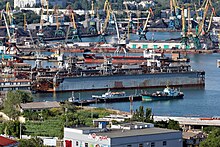Kerch port
The port of Kerch is a port in Kerch on the same Kerch Peninsula on the peninsula of Crimea .
history
In 1821 Genoa- born Raffaele Scassi, businessman and friend of Grand Duke Michael Pavlovich Romanov , brother of Tsar Alexander I , received permission to build the port of Kerch, was appointed governor of the port, a loan of 200 thousand rubles and a ten year old Tax exemption on imported and exported goods to and from the Caucasus . The port was opened in December 1822.
The port, which at that time was regularly called by foreign ships including Italian ships flying the Sardinian flag, is the last port of the Black Sea before entering the Sea of Azov and all ships that wanted to travel on were quarantined there . The quarantine in Kerch lasted two days in 1836 and two weeks in 1888.
"Yesterday, on the 1st of M. [September 1827], according to the highest order, the local quarantine port was ceremoniously opened in the presence of the Deputy Governor General of New Reussen , Privy Councilor Count Pahlen . "
In April 1830 there were 170 ships in the port of Kerch, 115 of which were in quarantine.
Prince Michail Semjonowitsch Voronzow , Governor General of New Russia and Bessarabia , recognized the importance of Kerch as a crucial trading hub and specifically promoted the city with its port.
“Because of the shallowness of the water, the ships cannot go as far as the Quai of Kerch, but stay at the quarantine building, where the sea is very deep and the ground for anchoring is safe. The Kerch quarantine is one of the most beautiful and best-equipped buildings of its kind in Europe, especially with regard to the precautionary measures that are taken here to ward off the plague . In this quarantine you can find everything that is good and useful that can only be found in the quarantines of Marseille , Genoa, Livorno and Trieste . "
Individual evidence
- ↑ Stefano Mensurati, Giulia Giacchetti Boico, Il genocidio Dimenticato. Gli italiani di Crimea, Libreria Editrice Goriziana, 2013, ISBN 9788861021723 (p. 4).
- ↑ Extra sheet for Rigaschen Zeitung No. 123 of June 1, 1855 (p. 5).
- ↑ Libausches Wochenblatt No. 44 of May 30, 1836 (p. 2).
- ↑ Rigasche Zeitung No. 70 of September 2, 1827 (p. 1).
- ↑ Rigasche Zeitung No. 54 of May 6, 1830 (p. 1).
- ↑ Extra sheet for Rigaschen Zeitung No. 123 of June 1, 1855 (p. 5).
Coordinates: 45 ° 21 ′ 31 ″ N , 36 ° 29 ′ 2 ″ E
